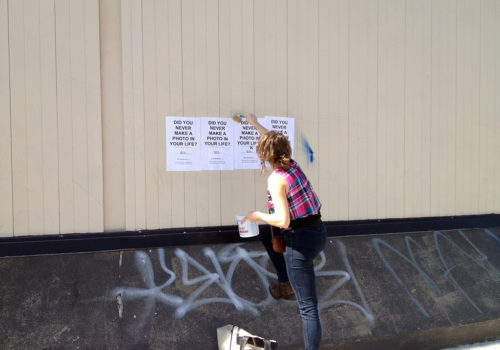We are overwhelmed by photographs. That’s a fact. And we’re all photographers, according to an exhibition at the Musée de L’Elysée six years ago. In 2012, a poster went up in Brooklyn searching for a rare specimen: someone who had never taken a photograph. The call had come from Anouk Kruithof, an artist who uses photography in her performance art, and the call was answered by Harrison Medina, a young man from the working-class neighborhood of Bedford-Stuyvesant who believes that, “a world without technology is cooler.” Together, they went through Kruithof’s archives and had a conversation free from the pretension of expertise, which was recorded and partially transcribed for the work Untitled (I’ve taken too many photos / I’ve never taken a photo). Kruithof’s method can seem brutal at times. “It’s too simple. Leave it out, please. It’s nothingness. It is blank and it is blue. I’m trying to explain it with the best of my ability,” says Medina at one point. But aren’t all subjects, to some extent, being used?
The interest lies more in some of his other reactions, and how the universality of photographic language seems inseparable from the viewer’s subjectivity. “It might take a lot of people back to a good place, so it is a good picture,” says Medina. Every kind of emotion comes to the surface, and this young man’s story is told through his reactions: “This picture relates to society. A lot of people are stuck in a bad position, sort of like myself. This is one of my favorite, because it is me in the picture. I am that donkey. […] He thinks, I am not getting paid human dollars.” Sometimes the pictures offer insight into the photographer’s private life: “The white van, the hearts – it seems like you were in love when you made this picture.”
« The picture can be your girlfriend. Like the picture is part of you now. You start a relationship with it. », expresses Harrison. And be the viewer Cartier-Bresson or someone else, there is always a decisive moment : « This looks like the perfect moment – in, 8. », he adds later. (NDLR: * stands for the printing size – 8 for large; 7 for medium; 6 for small). What we find out it that there might be a decisive moment for the viewer too :
HM : Do I have to take more out ?
AK : I think we are there.
HM : Phfoeeeeh. There were too many photos, definitely.
And if you are interested in going through the same experience, Kruithof’s book includes a poster bringing together the 300 original photographs, along with Harrison’s comments.
http://www.anoukkruithof.nl/work/ive-taken-too-many-photos-ive-never-taken-a-photo/
http://www.stresspress.biz/product/untitled-ive-taken-too-many-photos-ive-never-taken-a-photo
















